Government bond yields surged world-wide after a strong report on the U.S. labor market boosted investors’ expectations that central banks will begin steadily raising interest rates to fight inflation.
The benchmark 10-year U.S. Treasury yield, which helps set borrowing costs on everything from mortgages to corporate loans, settled at 1.930%, its highest close since December 2019. The 10-year German bund climbed to 0.2%, its highest level in nearly three years and further into positive territory after years below zero.
Yields, which rise as prices fall, began climbing in Europe after European Central Bank President Christine Lagarde on Thursday said inflation was higher and more sustained than expected, opening the door to interest-rate increases this year. Expectations that the Federal Reserve will raise rates multiple times in 2022 sparked an early year bond rout that has jarred financial markets, fueling declines in stocks and other riskier investments.
The moves extended after the U.S. Labor Department released data showing that U.S. employers added 467,000 jobs in January. That was well above forecasts from economists who had expected a larger drag from the latest wave of Covid-19 cases. Along with upward revision to previous months, the surprisingly strong report clears the path for the Fed to tighten policy.
The 10-year Treasury yield, which often climbs when investors expect longer-term growth and inflation, reversed an early descent immediately after the report. Yields on shorter-term Treasurys, which are especially sensitive to the outlook for near-term monetary policy, led gains, with the two-year yield settling at 1.322%, compared with 1.190% Thursday.
Taken together the moves signaled investors expect the U.S. economy is strengthening enough that steady rate increases won’t disrupt the longer-term outlook, some analysts said. While the shifts in European yields suggested a muddier picture, many expect monetary policy to tighten everywhere in coming months.
“All countries, even in Europe, are starting to accept that inflation is stickier,” said John Roe, head of multiasset funds at Legal & General Investment Management.
In one sign of potential stress, European yield-gains extended after Ms. Lagarde reignited fears about the ability of the eurozone’s weaker members to withstand higher borrowing costs.
Italy’s 10-year bond yield jumped the most since December 2020 on Thursday and rose again Friday, topping 1.75%. It was at 1.25% at the start of the week. The spread between the Italian bond yield and the German benchmark, considered a barometer of financial stress in the region, rose to its highest level in over 18 months.
The surge in yields weighed on the region’s stock markets, with the Euro Stoxx index closing 1.6% lower on Thursday and falling another 1.2% on Friday. The euro strengthened over 1% against the dollar on Thursday and appreciated further on Friday as traders anticipated that higher interest rates would attract capital flows to the eurozone.

ECB President Christine Lagarde noted that inflation was higher and more sustained than expected.
Photo: POOL/REUTERS
The bloc has a long history of divergent economic growth between the prosperous north, in countries such as Germany and the Netherlands, and the heavily indebted south, led by Italy, Greece and Spain. Forceful ECB action, including deeply negative policy rates and a massive bond-buying program—enlarged during the pandemic—have smothered fears about those differences.
But record-high inflation is forcing the ECB to play catch-up with the Federal Reserve, which signaled an interest-rate increase in March, and the Bank of England, which raised rates for the second time in a row on Thursday. A tightening of ECB policy threatens to snuff out the ultracheap borrowing that countries such as Italy have used to try to reset their economies coming out of the pandemic, and could cause a slowdown.
“As the ECB starts to normalize, that means more risk in southern European economies,” said Carsten Brzeski, global head of macro research at Dutch bank ING. They are more dependent on ECB support, he said.
Eurozone member states have a wide divergence in economic strength, with debt loads ranging from 206% for Greece and 156% for Italy to 70% for Germany at the end of 2020. Yet borrowing costs converged to a tighter band during the pandemic as the ECB bought bonds and kept yields artificially low, particularly for those with more unstable economies.
In one sign of worries that a tightening cycle will hamper Europe’s recovery, German shorter-dated bonds sold off more than longer-dated debt, flattening the yield curve at the fastest pace in nearly four months. The spread between two- and 30-year bond yields reached the lowest point since December on Friday.
The flatter yield curve is a sign of slower growth ahead, possibly even a recession if the monetary tightening is too strong, said Jorge Garayo, a fixed-income strategist at Société Générale.
Laurent Crosnier, chief investment officer at Amundi’s London branch, is betting that shorter-dated eurozone bonds will lose more value as the ECB follows the Fed and the Bank of England and tightens monetary policy.
“All these central banks are tightening, this is just the beginning of it,” Mr. Crosnier said.
Sam Goldfarb contributed to this article.
Write to Anna Hirtenstein at [email protected]
Copyright ©2022 Dow Jones & Company, Inc. All Rights Reserved. 87990cbe856818d5eddac44c7b1cdeb8








